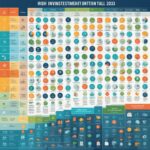Doubling money is a prospect that few people would turn down, and it isn’t necessarily that difficult to achieve. There are actually various ways to go about making this a reality, depending on your time line and tolerance for risk. You don’t need to buy speculative investments to double your money. A carefully balanced portfolio or even one just filled with super low-risk bonds can get the job done—provided that you are patient and not in a huge rush. Investors can strive toward doubling their money through a variety of methods, such as investing in stocks and bonds, purchasing rental properties, or creating passive income streams through various online platforms and assets. It’s important to assess your risk tolerance and have a long-term mindset when pursuing these strategies.
Key Takeaways:
- There are various strategies for doubling your money, depending on your risk tolerance and time frame.
- Investing in stocks and bonds is a classic approach that can yield significant returns over the long term.
- Contrarian investing involves buying when others are selling, potentially capitalizing on future price appreciation.
- Safe options, such as savings bonds and zero-coupon bonds, provide a lower-risk way to double your money.
- Speculative investments, like options trading and cryptocurrencies, come with higher risk but the potential for significant returns.
Five Ways to Double Your Money
When it comes to doubling your money, there are five key strategies that can help you achieve your financial goals. Whether you prefer a conservative approach or are willing to take on more risk, these strategies offer different paths to grow your wealth. It’s important to carefully consider your risk tolerance and investment horizon before deciding on the right strategy for you.
-
Invest in Diversified Stocks and Bonds
One of the most common ways to double your money is by investing in a diversified portfolio of stocks and bonds. By spreading your investments across different asset classes, you can potentially offset market volatility and achieve long-term growth. This strategy is well-suited for investors with a balanced risk appetite.
-
Take Advantage of Retirement and Tax-Advantaged Accounts
If you have access to retirement accounts like a 401(k), consider maximizing your contributions. These accounts offer tax advantages and potential employer matching, allowing you to grow your investments faster. By taking advantage of compound interest over time, you can double your money through consistent contributions and long-term growth.
-
Invest in Savings Bonds
Savings bonds are a conservative option for doubling your money over time. These bonds offer fixed interest rates and low risk, making them suitable for risk-averse investors. While the returns may be lower compared to other investment options, they provide stability and can be part of a diversified portfolio.
-
Consider Speculative Assets
If you’re comfortable with higher risk and have a higher risk tolerance, investing in speculative assets like penny stocks, options, or cryptocurrencies can offer the potential for significant returns. However, it’s important to conduct thorough research and understand the risks involved before investing in these volatile assets.
-
Generate Passive Income
Creating passive income streams can be a smart way to double your money over time. This can be achieved by investing in dividend stocks, rental properties, or peer-to-peer lending platforms. Passive income allows your money to work for you, generating ongoing cash flow without requiring active effort.
Remember, each strategy comes with its own set of pros and cons. It’s important to assess your financial goals, risk tolerance, and investment horizon before deciding on the best approach to double your money. A diversified portfolio that aligns with your investment objectives can provide the best chance for long-term growth and financial success.
The Classic Way
If you’re looking for a classic way to double your money, investing in a diversified portfolio of stocks and bonds is your best bet. Historically, the stock market has provided average annual returns of around 9.8%, while investment-grade bonds have returned around 7.0% annually. By creating a balanced portfolio that combines equities and fixed income assets, you can expect to double your money over a long-term period.
However, it’s important to keep in mind that this approach comes with volatility and occasional sharp drawdowns. Stay patient and maintain a long-term mindset, as investing in stocks and bonds requires riding out market fluctuations. With time and careful consideration, you can maximize your investment returns and achieve your financial goals.
Here’s an overview of the classic way to double your money through investing in stocks and bonds:
| Investment | Average Annual Return |
|---|---|
| Stock Market | 9.8% |
| Investment-Grade Bonds | 7.0% |
As you can see from the table above, the stock market tends to provide higher returns compared to investment-grade bonds. However, bonds offer a more stable and predictable income stream. It’s important to find the right balance between stocks and bonds that aligns with your risk tolerance and investment goals.
Remember, successful investing requires a well-diversified portfolio and a long-term approach. By staying informed, regularly reviewing your investments, and making adjustments when necessary, you can maximize your chances of doubling your money through the classic way of investing in stocks and bonds.
Key Takeaways
- Investing in a diversified portfolio of stocks and bonds is a classic way to double your money.
- The stock market has historically provided average annual returns of around 9.8%, while investment-grade bonds have returned around 7.0% annually.
- Creating a balanced portfolio with a mix of equities and fixed income assets is crucial for long-term investing success.
- Stay patient and maintain a long-term mindset to ride out market fluctuations.
- Regularly review and adjust your investments to maximize your chances of doubling your money.
The Contrarian Way
When it comes to doubling your money, going against the grain can be a surprisingly effective strategy. Contrarian investing involves buying when others are selling and the market is experiencing a slump. By taking a contrarian approach, you have the opportunity to invest in stocks or assets that have been oversold and are trading below their intrinsic value.
This approach to investing requires a greater degree of risk tolerance and a willingness to do thorough research. It’s important to look for opportunities where market sentiment is overwhelmingly negative, as this can provide the chance to capitalize on future price appreciation.
“Be fearful when others are greedy, and greedy when others are fearful.” – Warren Buffett
Contrarian investing is not for everyone. It is best suited for experienced investors who have the knowledge and experience to identify undervalued investments during market slumps. Conservative or inexperienced individuals may find this approach too risky or challenging to navigate.
One key aspect of contrarian investing is the concept of value investing. Value investors seek out stocks or assets that they believe are trading below their intrinsic value. By buying assets at a discounted price, investors can potentially benefit from future price appreciation when the market eventually recognizes its true value.
Benefits of the Contrarian Approach
So why consider a contrarian approach to double your money? Here are a few potential benefits:
- Potential for higher returns: By investing in undervalued assets, there is the possibility of significant capital gains when the market sentiment shifts and the asset’s value increases.
- Diversification: Contrarian investing can help diversify your investment portfolio. By adding assets that have low or negative correlations with the broader market, you can reduce the overall risk of your portfolio.
- Long-term perspective: Contrarian investing often requires a long-term mindset. While there may be short-term volatility and uncertainty, taking a contrarian approach allows you to focus on the long-term potential of your investments.
It’s important to note that contrarian investing is not without risks. Market sentiment can sometimes be justified, and there is always the possibility of further price declines. Thorough research, analysis, and a disciplined investment strategy are essential to mitigate these risks.
Creating a Contrarian Investment Strategy
If you’re considering a contrarian approach to double your money, here are some steps to take:
- Research and analysis: Conduct thorough research and analysis to identify assets that are trading below their intrinsic value. Look for factors that may be causing the market to undervalue the asset, such as temporary challenges or negative sentiment.
- Patience: Contrarian investing requires patience. It may take time for the market sentiment to shift and for the asset’s value to be recognized. Be prepared to hold your investments for the long term.
- Diversification: As with any investment strategy, diversification is key. Spread your investments across different industries and asset classes to reduce risk and increase the potential for positive returns.
- Manage your risk: Setting strict risk management rules is crucial when taking a contrarian approach. Determine your risk tolerance and establish stop-loss orders or other risk mitigation measures to protect your investment capital.
Remember, contrarian investing is not a guaranteed way to double your money. Market conditions can be unpredictable, and there is always a level of risk involved. However, with careful research, analysis, and a contrarian mindset, you may be able to identify investment opportunities that have the potential to provide significant returns.
Contrarian Investing Example:
To illustrate the potential of contrarian investing, let’s look at a hypothetical example:
| Company | Industry | Recent Stock Price | Intrinsic Value | Contrarian Opportunity? |
|---|---|---|---|---|
| ABC Corporation | Technology | $50 | $70 | Yes |
| XYZ Inc. | Automotive | $30 | $40 | Yes |
| 123 Co. | Healthcare | $80 | $75 | No |
In this example, both ABC Corporation and XYZ Inc. are trading below their intrinsic values, presenting potential contrarian opportunities. However, 123 Co. is trading above its intrinsic value, indicating that it may not be the best contrarian investment option.
By carefully evaluating and selecting undervalued assets like ABC Corporation and XYZ Inc., a contrarian investor may be able to take advantage of future price appreciation and potentially double their money.
The Safe Way
When it comes to doubling your money, some individuals prefer a safe and steady approach rather than taking on higher risk. For those seeking a safe way to double their money, investing in safe assets such as savings bonds or zero-coupon bonds can be an attractive option.
Savings bonds and zero-coupon bonds provide a lower return compared to stocks or high-risk investments. However, they come with the advantage of less volatility and risk. This makes them suitable for individuals who prioritize the preservation of their capital.
One option for safe investments is savings bonds. These are issued by the government and offer a fixed interest rate over a specific period. The interest earned is added to the bond’s principal value, allowing your investment to grow over time. With savings bonds, you have the peace of mind knowing that your investment is backed by the government.

Zero-coupon bonds are another safe investment option. These bonds do not pay periodic interest like traditional bonds. Instead, they are sold at a discount to their face value and gradually increase in value over time until they reach their full face value at maturity. At that point, investors receive the full face value of the bond.
Investing in safe assets like savings bonds or zero-coupon bonds requires patience, as it may take a longer time frame to double your money compared to higher-risk investments. However, the stability and security they offer can be appealing for risk-averse individuals.
Comparison: Savings Bonds vs. Zero-Coupon Bonds
| Type of Bond | Key Features | Risk Level | Return Potential |
|---|---|---|---|
| Savings Bonds | Issued by the government Fixed interest rate Interest added to principal value |
Low | Fixed return |
| Zero-Coupon Bonds | Sold at a discount to face value No periodic interest payments Full face value received at maturity |
Low | Fixed return |
As shown in the table above, both savings bonds and zero-coupon bonds offer a low-risk investment option for individuals seeking a safe way to double their money. While the returns may be modest compared to riskier investments, the stability and predictability they provide can be valuable for long-term financial planning.
The Speculative Way
In the quest to double your money, there is a speculative approach that involves taking on higher risk through options trading, penny stocks, and cryptocurrencies. While these investments offer the potential for significant returns, it’s important to note that they also come with a higher probability of loss.
Speculative investing requires thorough research, a deep understanding of market trends, and a high level of risk tolerance. It’s crucial to carefully assess the potential risks and rewards associated with these investments before proceeding.
Options trading allows investors to speculate on the future price movements of stocks, indices, commodities, and other financial instruments. By purchasing call or put options, investors can potentially profit from price changes or fluctuations in the underlying asset.
Penny stocks, also known as low-priced or small-cap stocks, are shares of companies with a low market capitalization. These stocks often trade at a fraction of a dollar and are considered speculative due to their higher volatility and potential lack of liquidity.
Cryptocurrencies, such as Bitcoin and Ethereum, have gained significant attention in recent years. These digital assets operate using blockchain technology and can experience significant price volatility. Investing in cryptocurrencies requires a deep understanding of the underlying technology, market dynamics, and regulatory environment.
It’s important to approach speculative investing with caution and only invest money that you can afford to lose. Due to the higher risks involved, it’s advisable to diversify your portfolio and consult with a qualified financial advisor who specializes in these types of investments.
Remember, the speculative approach presents the potential for high returns, but it’s essential to carefully assess the risks and make well-informed decisions.
Passive Income
Passive income is an essential concept when it comes to financial success. It refers to regular earnings that you can generate from sources other than active employment. By establishing passive income streams, you can create a reliable source of income that requires minimal effort on your part.
There are various ways to generate passive income, and it often involves an upfront investment of either money, time, or both. However, once established, passive income streams can provide financial security and the ability to generate extra cash flow, especially during times of economic uncertainty.
Passive income can come from different sources, including:
- Rental property income: By owning and renting out properties, you can earn passive rental income. Real estate investment can be a great way to generate passive income, but it requires careful property management and tenant selection.
- Investment income: Investments such as stocks, bonds, and dividend-paying assets can generate passive income in the form of dividends, interest, or capital gains. Building a well-diversified investment portfolio is crucial for long-term success.
- Online platforms: If you have expertise in a specific area, creating and monetizing online content through platforms like blogs, videos, and podcasts can be a lucrative passive income stream. You can earn through advertising, sponsorships, or product promotions.
Generating passive income requires careful planning, research, and the right investment approach. It’s essential to assess your risk tolerance, time frame, and financial goals when choosing passive income strategies. Diversification is key to mitigating risk and maximizing returns.
Passive income provides the opportunity to achieve financial independence and build long-term wealth.
Here’s an image that represents the concept of generating passive income:

With passive income, you can enjoy the benefits of financial freedom and flexibility. Whether you’re aiming to supplement your current income or create a stream of income that supports your desired lifestyle, passive income streams can be a valuable asset.
In the next section, I will discuss the benefits of investing in dividend stocks as a way to generate passive income.
Dividend Stocks
Dividend stocks are a popular choice for individuals looking to earn passive income from their investments. These stocks have the potential to provide a steady stream of income, making them an attractive option for those seeking to supplement their earnings or build long-term wealth.
When you buy dividend stocks, you become a shareholder in the company. As a shareholder, you are entitled to receive a portion of the company’s earnings in the form of regular dividend payments. These payments are typically made quarterly, although some companies may distribute them on a monthly or annual basis.
One of the key advantages of investing in dividend stocks is the potential for a growing income stream over time. Many companies aim to increase their dividend payout year after year, which can result in higher dividend payments for shareholders. This can be especially beneficial during times of inflation or economic downturn, as dividend income has the potential to maintain its purchasing power.
Investors can choose to use their dividend income in various ways. Some may prefer to reinvest the dividends back into the stock, which can result in the compounding of their investment over time. Others may use the dividend income to cover living expenses or reinvest in other opportunities.
Diversification and Stability
One of the benefits of incorporating dividend stocks into an investment portfolio is diversification. Dividend stocks are typically offered by companies across different sectors, such as technology, healthcare, finance, and consumer goods. By investing in dividend stocks from various sectors, investors can spread their risk and potentially mitigate the impact of a decline in one particular industry.
Furthermore, dividend stocks are often considered to be less volatile than growth stocks. While growth stocks primarily focus on capital appreciation, dividend stocks provide a more stable income stream through their regular dividend payments. This stability can be attractive to conservative investors or those who prioritize consistent income generation.
Considerations for Dividend Investing
When investing in dividend stocks, there are a few key considerations to keep in mind:
- Dividend Yield: The dividend yield represents the annual dividend payment as a percentage of the stock price. Investors may look for stocks with higher dividend yields, although it’s important to assess the underlying company’s financial health to ensure the sustainability of the dividend payments.
- Dividend Growth: Companies that consistently increase their dividend payments over time may provide a greater potential for long-term income growth. Investors can research a company’s dividend history and track record of dividend growth before making an investment decision.
- Company Financials: It’s essential to assess the financial health of a company before investing in its stock. Factors such as revenue growth, profitability, and debt levels can impact the company’s ability to sustain and increase dividend payments.
- Market Conditions: Like any investment, dividend stocks can be influenced by market conditions. Economic factors, industry trends, and market volatility can impact the performance of dividend stocks. It’s important to stay informed and regularly review your investment portfolio.
By considering these factors and conducting thorough research, investors can identify dividend stocks that align with their investment goals and risk tolerance. Building a diversified portfolio of dividend stocks can provide a consistent income stream and potential for long-term wealth accumulation.
Rental Properties
Investing in rental properties is a lucrative way to generate passive income. By purchasing properties and renting them out to tenants, you can enjoy a steady stream of rental income. Rental properties offer a reliable cash flow, especially in high-demand areas where there is a constant need for rental housing.
However, owning and managing rental properties come with responsibilities. You need to handle property maintenance, tenant management, and potential vacancies. It’s crucial to carefully assess the potential rental income, expenses, and risks associated with owning rental properties before making any investments.
When evaluating potential rental properties, consider factors such as location, rental demand, property condition, and market trends. Conduct thorough research and analysis to ensure the property’s rental income covers expenses and generates a positive cash flow.
Additionally, it’s essential to screen potential tenants to find reliable individuals who will pay rent on time and take care of the property. Diligently managing the property and promptly addressing any maintenance or tenant issues can help maximize rental income and minimize vacancy periods.
A well-managed rental property can provide a consistent passive rental income, making it an attractive option for real estate investing. Just be prepared to put in the necessary effort and take on the responsibilities that come with being a landlord.
“Investing in rental properties can be a great way to generate passive income. By leveraging the power of real estate, you can enjoy regular rental income and potentially build wealth over time.”
Peer-to-Peer Lending
Peer-to-peer lending platforms offer individuals the opportunity to earn passive income by lending money to borrowers. These lending platforms connect borrowers with lenders and provide a platform for loan transactions. Investors can earn interest income by lending money to borrowers and receive regular repayments over a designated period of time.
Peer-to-peer lending can provide a higher return compared to traditional bank savings accounts, but it also comes with the risk of potential default by borrowers. It’s important to carefully assess the creditworthiness of borrowers and diversify investments across multiple loans to mitigate risks.
The Benefits of Peer-to-Peer Lending
- Diversify Investment Portfolio: Peer-to-peer lending offers an opportunity to diversify your investment portfolio beyond traditional asset classes like stocks and bonds.
- Higher Returns: By lending money directly to borrowers, investors can potentially earn higher returns compared to savings accounts or other low-risk investments.
- Regular Income Stream: Lenders receive regular repayments from borrowers, providing a steady income stream that can contribute to financial stability.
- Lower Barrier to Entry: Peer-to-peer lending platforms often have lower minimum investment requirements compared to traditional investment options, making it accessible to a wider range of investors.
However, it’s important to note that peer-to-peer lending carries risks, including the potential for default by borrowers. Lenders should carefully assess the creditworthiness of borrowers and consider diversifying their investments across multiple loans to mitigate these risks.
Investing in peer-to-peer lending can be a rewarding way to earn passive income and diversify your investment portfolio. However, it’s crucial to conduct thorough research, assess the creditworthiness of borrowers, and diversify your investments to minimize risks.
In the next section, we will explore another passive income strategy: creating online content.
Creating Online Content
Creating online content is a powerful way to not only share valuable information or entertainment but also generate passive income. Whether you’re passionate about writing, making videos, or hosting podcasts, there are various online platforms where you can showcase your creativity and expertise.
By consistently providing value to your audience, you can build a loyal following and attract advertisers, sponsors, or affiliate partnerships. Monetizing your content through advertising, sponsorships, or product promotions can turn your passion into a profitable passive income stream.
It’s important to note that creating online content requires consistent effort and ongoing maintenance to ensure its success. You’ll need to produce high-quality content, engage with your audience, and stay updated with the latest trends in your niche.
“Creating online content is like building a virtual business. It requires dedication, authenticity, and the willingness to adapt to the ever-changing digital landscape.”
– Sarah Thompson, Successful Content Creator
One effective strategy to monetize your online content is through sponsored content or partnerships. Brands value the authentic connection you have with your audience and may be willing to pay for sponsored posts, videos, or mentions that align with their products or services.
Additionally, you can explore affiliate marketing, where you earn a commission for promoting products or services and driving sales through your unique affiliate links. This can be a lucrative way to generate passive income as you leverage your influence and expertise.
Benefits of Creating Online Content:
- Flexibility to work on your own terms and schedule.
- Opportunity to showcase your skills and expertise.
- Potential to reach a global audience and build your personal brand.
- Diversify your income sources and generate passive income.
- Create valuable connections and collaborations within your industry.
Remember, consistency is key when creating online content. Regularly publish high-quality content, engage with your audience, and adapt your strategies based on their feedback and preferences. With dedication and perseverance, you can turn your passion for content creation into a successful and fulfilling source of passive income.
| Monetization Strategies | Pros | Cons |
|---|---|---|
| Advertising |
|
|
| Sponsorships |
|
|
| Affiliate Marketing |
|
|
Investing in Dividend Index Funds and ETFs
If you’re looking to generate passive income from dividend stocks, investing in dividend index funds and exchange-traded funds (ETFs) can be an excellent option. These funds offer a convenient and diversified approach to dividend investing, allowing you to benefit from a portfolio of dividend-generating companies without the need to select and manage individual stocks yourself.
Dividend index funds and ETFs hold a collection of dividend-paying stocks, typically those included in a specific index such as the S&P 500 Dividend Aristocrats Index. This ensures that you gain exposure to a broad range of companies with a consistent track record of paying dividends.
One of the key advantages of investing in dividend index funds and ETFs is the hands-off approach they offer. These funds automatically reinvest dividends, allowing your investment to grow over time without requiring any additional effort on your part. Additionally, dividend index funds and ETFs provide diversification, reducing the risk associated with relying on the performance of a single stock or sector.
By investing in dividend index funds or ETFs, you can take advantage of the passive income generated by a portfolio of dividend stocks, all while enjoying the benefits of simplicity and diversification.
Benefits of Investing in Dividend Index Funds and ETFs
- Convenience: Investing in dividend index funds and ETFs is a convenient and time-saving option, as it eliminates the need for extensive research and individual stock selection.
- Growth Potential: By reinvesting dividends, your investment can grow steadily over time, potentially leading to increased passive income and long-term wealth accumulation.
- Diversification: Dividend index funds and ETFs hold a portfolio of dividend-paying stocks from various sectors, providing you with a diversified investment that can help mitigate risk.
- Lower Costs: Investing in dividend index funds and ETFs often comes with lower expenses compared to actively managed funds, allowing you to keep more of your investment returns.
Whether you’re a seasoned investor or just starting your investment journey, dividend index funds and ETFs offer a compelling way to generate passive income from dividend stocks. By harnessing the power of these funds, you can enjoy the benefits of simplicity, diversification, and potential long-term growth.
| Fund Name | Expense Ratio | Dividend Yield |
|---|---|---|
| Vanguard Dividend Appreciation ETF (VIG) | 0.06% | 1.87% |
| iShares Select Dividend ETF (DVY) | 0.39% | 3.12% |
| Schwab U.S. Dividend Equity ETF (SCHD) | 0.06% | 3.25% |
Note: Dividend yields and expense ratios are subject to change. Please refer to the fund prospectus for the most up-to-date information.
Bonds and Bond Index Funds
Investing in bonds and bond index funds is a popular strategy for generating passive income. Bonds are debt instruments issued by companies or governments to raise capital. When you invest in bonds, you become a bondholder and receive regular interest payments. This makes bonds an attractive option for individuals seeking fixed income investments.

Bond index funds, on the other hand, are mutual funds or exchange-traded funds (ETFs) that track a specific bond index. These funds aim to replicate the performance of the index by holding a diversified portfolio of bonds. By investing in bond index funds, you can gain exposure to a range of different types of debt securities.
Benefits of Investing in Bonds
- Bonds are generally considered lower-risk investments compared to stocks, making them a suitable option for conservative investors.
- Bonds provide a fixed stream of income through regular interest payments, offering stability in income generation.
- Investors can choose from various types of bonds, such as government bonds, corporate bonds, or municipal bonds, to meet their investment objectives.
Advantages of Bond Index Funds
- Bond index funds offer diversification by investing in a broad range of bonds, reducing the risk associated with investing in individual bonds.
- These funds typically have low expense ratios, making them cost-effective investment options.
- Investing in bond index funds allows investors to gain exposure to the overall performance of the bond market without the need for extensive research or individual bond selection.
- Bonds are generally considered lower-risk investments compared to stocks, making them a suitable option for conservative investors.
- Bonds provide a fixed stream of income through regular interest payments, offering stability in income generation.
- Investors can choose from various types of bonds, such as government bonds, corporate bonds, or municipal bonds, to meet their investment objectives.
Advantages of Bond Index Funds
- Bond index funds offer diversification by investing in a broad range of bonds, reducing the risk associated with investing in individual bonds.
- These funds typically have low expense ratios, making them cost-effective investment options.
- Investing in bond index funds allows investors to gain exposure to the overall performance of the bond market without the need for extensive research or individual bond selection.
- Bond index funds offer diversification by investing in a broad range of bonds, reducing the risk associated with investing in individual bonds.
- These funds typically have low expense ratios, making them cost-effective investment options.
- Investing in bond index funds allows investors to gain exposure to the overall performance of the bond market without the need for extensive research or individual bond selection.
Investing in bonds and bond index funds can be an effective way to generate passive income while managing risk. Whether you choose to invest in individual bonds or opt for the diversification provided by bond index funds, bonds offer a stable income stream for those seeking fixed income investments.
High-Yield Savings Accounts
When it comes to generating passive income, high-yield savings accounts offer a simple yet effective strategy. These accounts provide individuals with the opportunity to earn a higher interest rate on their savings compared to traditional savings accounts. By taking advantage of the attractive interest rates offered by these accounts, you can increase your passive income and watch your savings grow.
One of the notable advantages of high-yield savings accounts is their low risk. Unlike riskier investment options, such as stocks or real estate, these accounts offer a safe haven for your hard-earned money. This makes them particularly attractive for individuals who prioritize the security of their savings.
While the returns from high-yield savings accounts may not be as impressive as those from more aggressive investment strategies, they come with the benefit of liquidity and easy accessibility to funds. This means that you can access your money whenever you need it without the risk of penalties or long-term commitments.
High-yield savings accounts are an excellent option for building an emergency fund or saving for short-term financial goals. Whether you’re planning for unexpected expenses or saving up for a dream vacation, these accounts allow you to earn passive income while keeping your money readily available.
Key Benefits of High-Yield Savings Accounts:
- Earn a higher interest rate compared to traditional savings accounts
- Low-risk investment option
- Liquidity and easy accessibility to funds
- Ideal for building an emergency fund or saving for short-term goals
So, if you’re looking for a reliable and low-risk way to generate passive income, consider opening a high-yield savings account. It’s a smart financial move that allows you to earn more from your savings while maintaining liquidity and accessibility.
Don’t miss out on the opportunity to grow your savings and enjoy the benefits of passive income. Start exploring high-yield savings account options today and take control of your financial future.
Real Estate Investment Trusts (REITs)
When it comes to generating passive income from real estate, real estate investment trusts (REITs) provide a compelling option. REITs are companies that own and manage income-generating properties, such as office buildings, shopping malls, or apartment complexes. By investing in REITs, individuals can gain exposure to the real estate market and earn regular income through dividends.
REITs offer several advantages that make them an attractive option for passive real estate investing. One of the key benefits is diversification. Through REITs, investors can access a portfolio of properties across different sectors and geographical locations, reducing the risk associated with investing in a single property. Additionally, REITs are professionally managed, allowing investors to benefit from the expertise and experience of real estate professionals.
Another advantage of investing in REITs is liquidity. Unlike privately owned properties, REITs can be easily bought and sold on the stock market, providing investors with greater flexibility and accessibility to their investments.
To make informed investment decisions, it’s important to research and select REITs that align with your investment goals and risk tolerance. Consider factors such as the type of properties in a REIT’s portfolio, the stability of rental income, and the track record of dividend payments. Look for REITs that have a proven track record of delivering consistent returns and have a strong balance sheet.
Overall, REITs offer a passive and convenient way to invest in real estate and generate regular income. With the potential for diversification, professional management, and liquidity, REITs can be a valuable addition to a diversified investment portfolio.

Investing in REITs: Key Considerations
“REITs provide individuals with a simple and accessible way to invest in real estate and generate passive income. However, it’s important to consider a few key factors when investing in REITs:”
- Research and understand the types of properties within a REIT’s portfolio
- Evaluate the stability and predictability of rental income
- Assess the track record of dividend payments and potential for dividend growth
- Consider the financial strength and balance sheet of the REIT
- Seek professional advice or consult with a financial advisor
| Advantages of Investing in REITs | Considerations |
|---|---|
| Diversification through a portfolio of properties | Research and understand the types of properties within a REIT’s portfolio |
| Professional management by experienced real estate professionals | Evaluate the stability and predictability of rental income |
| Liquidity and ease of buying and selling on the stock market | Assess the track record of dividend payments and potential for dividend growth |
| Attractive dividend yields and potential for income growth | Consider the financial strength and balance sheet of the REIT |
Conclusion
In conclusion, there are various strategies for achieving financial success and generating passive income. By utilizing smart investment strategies such as investing in stocks and bonds, owning rental properties, or creating online content, individuals can establish streams of income that require minimal effort once set up.
When deciding on passive income strategies, it is crucial to assess your risk tolerance, timeframe, and investment goals. This will ensure that you choose the right approach that aligns with your personal circumstances and objectives. Diversification, thorough research, and a long-term mindset are essential for achieving financial success through passive income.
While building passive income may take time and consistent effort, the rewards can be significant. With the right strategies and mindset, you can attain financial independence and long-term wealth. Remember, success in passive income lies in diligently implementing your chosen strategies and staying committed to your goals.
FAQ
What are some strategies for making money with money?
Some strategies for making money with money include investing in stocks and bonds, purchasing rental properties, creating passive income streams through online platforms, and maximizing returns through various investment vehicles.
What are five ways to double your money?
There are five key strategies for doubling your money: investing in a diversified portfolio of stocks and bonds, capitalizing on market slumps through contrarian investing, investing in safe assets like savings bonds, taking on higher risk through speculative investments, and generating passive income through various sources.
What is the classic way to double your money?
The classic way to double your money is by investing in a diversified portfolio of stocks and bonds. By creating a balanced portfolio with a mix of equities and fixed income assets, investors can expect to double their money over an extended period of time.
How can you double your money through the contrarian approach?
The contrarian approach to doubling your money involves buying assets that have been oversold and are trading below their intrinsic value. By capitalizing on market slumps and going against the prevailing investor sentiment, investors can potentially benefit from future price appreciation.
Is there a safe way to double your money?
Yes, investing in safe assets such as savings bonds or zero-coupon bonds can be a safer option for doubling your money. These assets offer lower returns compared to stocks or high-risk investments, but they also come with less volatility and risk.
What is the speculative way to double your money?
The speculative way to double your money involves taking on higher risk through options trading, penny stocks, and cryptocurrencies. While these investments have the potential for significant returns, they also come with a higher probability of loss and should be made with caution.
What is passive income?
Passive income refers to regular earnings from a source other than active employment. It can come from various sources such as rental property income, investment income, or revenue generated from online platforms. Passive income streams require an upfront investment of either money, time, or both, but can generate income over an extended period of time with little or no daily effort.
How can you generate passive income through dividend stocks?
Dividend stocks distribute a portion of the company’s earnings to shareholders as regular dividend payments. By investing in dividend stocks, individuals can earn a steady stream of income, especially if the company consistently increases its dividend payout over time.
How can you generate passive income through rental properties?
Investing in rental properties allows individuals to earn regular rental income. By owning properties and renting them out to tenants, individuals can benefit from a reliable source of cash flow, especially in areas with high demand for rental housing.
What is peer-to-peer lending and how can it generate passive income?
Peer-to-peer lending platforms connect borrowers with lenders and provide a platform for loan transactions. By lending money to borrowers through these platforms, individuals can earn interest income and receive regular repayments over a designated period of time.
How can creating online content generate passive income?
By sharing valuable information or entertainment through various online platforms, content creators can attract an audience and monetize their content through advertising, sponsorships, or product promotions, generating passive income over time.
How can investing in dividend index funds and ETFs generate passive income?
Investing in dividend index funds or ETFs allows individuals to gain exposure to a diversified portfolio of dividend-paying stocks. These funds automatically reinvest dividends and provide diversification, enabling individuals to benefit from the passive income generated by a portfolio of dividend stocks without actively managing individual stocks.
How can investing in bonds and bond index funds generate passive income?
By investing in high-quality bonds or bond index funds, individuals can earn passive income in the form of regular interest payments. Bonds are generally considered lower-risk investments compared to stocks and can provide a stable income stream for those seeking passive income.
How can high-yield savings accounts generate passive income?
High-yield savings accounts offer higher interest rates compared to traditional savings accounts, allowing individuals to earn more from their savings. These accounts provide a safe and low-risk option for individuals to earn passive income on their savings.
How can investing in real estate investment trusts (REITs) generate passive income?
REITs are companies that own and manage income-generating properties. By investing in REITs, individuals can gain exposure to the real estate market and earn regular income through dividend payments, providing a passive income stream from real estate.
Our Friends
- https://www.investopedia.com/articles/stocks/09/five-ways-double-investment.asp
- https://www.bankrate.com/investing/passive-income-ideas/
- https://www.nerdwallet.com/article/investing/what-is-passive-income-and-how-do-i-earn-it
Money posts:
 How to Invest $1 Million Dollars: Strategies and Tips for Growth and Security
How to Invest $1 Million Dollars: Strategies and Tips for Growth and Security
 Stocks vs. Bonds: Understanding the Pros & Cons of Each
Stocks vs. Bonds: Understanding the Pros & Cons of Each
 11 Ways to Invest and Make Money Daily in 2024
11 Ways to Invest and Make Money Daily in 2024
 12 Best Investments for 2024
12 Best Investments for 2024
 What is Passive Income & Why It’s So Important in 2024
What is Passive Income & Why It’s So Important in 2024
 11 Best Low-Risk Investments with High Returns in 2024
11 Best Low-Risk Investments with High Returns in 2024
 13 Best High-Yield Investments for 2024
13 Best High-Yield Investments for 2024
 9 Best Investments for a Roth IRA (2024)
9 Best Investments for a Roth IRA (2024)

